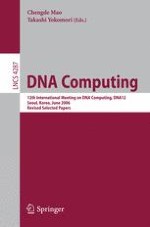2006 | Book
DNA Computing
12th International Meeting on DNA Computing, DNA12, Seoul, Korea, June 5-9, 2006, Revised Selected Papers
Editors: Chengde Mao, Takashi Yokomori
Publisher: Springer Berlin Heidelberg
Book Series : Lecture Notes in Computer Science
